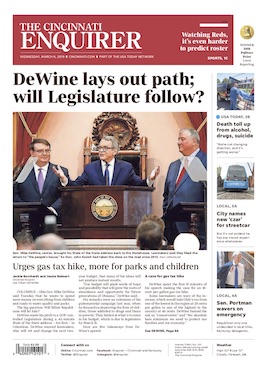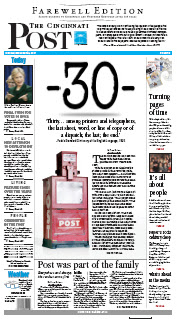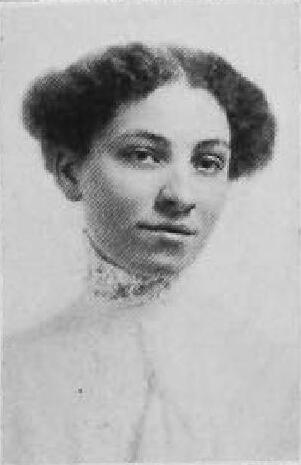
Nam June Paik was a Korean artist. He worked with a variety of media and is considered to be the founder of video art. He is credited with the first use (1974) of the term "electronic super highway" to describe the future of telecommunications.

WSTR-TV, branded Star 64, is a television station in Cincinnati, Ohio, United States, affiliated with MyNetworkTV. It is owned by Deerfield Media, which maintains a local marketing agreement (LMA) with Sinclair Broadcast Group, owner of dual CBS/CW affiliate WKRC-TV, for the provision of advertising sales and other services. The two stations share studios on Highland Avenue in the Mount Auburn section of Cincinnati; WSTR's transmitter, Star Tower, is located in the city's College Hill neighborhood.

Kentucky Speedway is an inactive 1.5 miles (2.4 km) tri-oval intermediate speedway in Sparta, Kentucky. It has hosted various major races throughout its existence, including NASCAR and IndyCar races. The track is currently owned by Speedway Motorsports, LLC (SMI) and is currently used as a storage and parking lot for various companies. The speedway has a grandstand capacity of 66,000 as of 2020, down from its peak of 106,000 in the early 2010s. It was last led by track general manager Mark Simendinger, who left SMI in 2020. Kentucky Speedway is served by Interstate 71 and Kentucky Route 35.

Cincinnati Bell, Inc., doing business as Altafiber, is a regional telecommunications service provider based in Cincinnati, Ohio, United States. It provides landline telephone, fiber-optic Internet, and IPTV services through its subsidiaries Altafiber Home Phone and Hawaiian Telcom, which are the incumbent local exchange carriers for the Greater Cincinnati metropolitan area and Hawaii. Other subsidiaries provide enterprise information technology services and long distance calling.

The Cincinnati Enquirer is a morning daily newspaper published by Gannett in Cincinnati, Ohio, United States.

The Cincinnati Post was an afternoon daily newspaper published in Cincinnati, Ohio, United States. In Northern Kentucky, it was bundled inside a local edition called The Kentucky Post.

The Nutter Center is a multi-purpose arena located at Wright State University, in Fairborn, Ohio. It mainly serves as the home court of the Wright State Raiders men's and women's basketball teams. It is also regularly used as a music venue for touring concerts and shows and for area high school graduation ceremonies.

WCPO-TV is a television station in Cincinnati, Ohio, United States, affiliated with ABC. It is the flagship television property of locally based E. W. Scripps Company, which has owned the station since its inception. WCPO-TV's studios are located in the Mount Adams neighborhood of Cincinnati next to the Elsinore Arch, and its transmitter is located at the site of the station's original studios on Symmes Street, in the Walnut Hills section of the city.

WXIX-TV is a television station licensed to Newport, Kentucky, United States, serving the Cincinnati metro as the market's Fox affiliate. It is owned by Gray Television alongside low-power Telemundo affiliate WBQC-LD and 24/7 weather channel WZCD-LD. The three stations share studios at 19 Broadcast Plaza on Seventh Street in the Queensgate neighborhood just west of downtown Cincinnati; WXIX-TV's transmitter is located in the South Fairmount neighborhood on the city's northwest side.

Forest Fair Village is an abandoned enclosed shopping mall in the northern suburbs of Cincinnati, Ohio, United States. It is situated on the border between Forest Park and Fairfield, at the junction of Interstate 275 and Winton Road. The mall, built in phases between 1988 and 1989 as Forest Fair Mall, has become noted for its troubled history; despite being the second-biggest mall in the state and bringing many new retailers to the market, it lost three anchor stores and its original owner LJ Hooker to bankruptcy less than a year after opening. The mall underwent renovations throughout the mid 1990s, attracting new stores such as Kohl's, Burlington Coat Factory, and Bass Pro Shops. Mills Corporation renamed the property to Cincinnati Mills in 2002 and renovated the mall once more in August 2004. Following the sale of Mills's portfolio to Simon Property Group, the mall was sold several times afterward, while continuing to lose many of its key tenants. After having been renamed to Cincinnati Mall and again to Forest Fair Village in the 2010s, the property received significant media attention as an example of a dead mall. It also received a number of proposals for renovation, none of which were realized. Following years of tenancy decline, it closed to the public on December 2, 2022.

Covington Catholic High School is a private, Roman Catholic, high school for boys in Park Hills, Kentucky, United States. It was founded in 1925 by Bishop Francis William Howard and Brother George Sauer, and is part of the Roman Catholic Diocese of Covington. The school is the only boys' high school in northern Kentucky and one of five in the Cincinnati area. The girls' Notre Dame Academy is located across the street.

The Contemporary Arts Center is a contemporary art museum in Cincinnati, Ohio and one of the first contemporary art institutions in the United States. The CAC is a non-collecting museum that focuses on new developments in painting, sculpture, photography, architecture, performance art and new media. Focusing on programming that reflects "the art of the last five minutes", the CAC has displayed the works of many now-famous artists early in their careers, including Andy Warhol. In 2003, the CAC moved to a new building designed by Zaha Hadid.
Lois Rosenthal was an American author, publisher, arts & humanities philanthropist, and community volunteer. She was based in Cincinnati, Ohio. She served on the boards of the Cincinnati Art Museum, Cincinnati Playhouse in the Park, Freestore Foodbank, Art Links, Cincinnati Museum Center, and the Mercantile Library of Cincinnati. She was known for her hands-on philosophy of service in her community and was named Enquirer Woman of the Year in 1999 by The Cincinnati Enquirer.
The Formica Building is a mixed-use building in Cincinnati, Ohio, United States.
Russell "Russ" Wilson was an American politician and newspaper editor. He was the mayor of Cincinnati, Ohio from 1930 to 1937. He was a founder of Sigma Sigma honor society in 1898.

Jennie Davis Porter was an American educator. She was the first African-American to receive a PhD from the University of Cincinnati and became the first black female principal of a public school in Cincinnati. In 1989, she was posthumously inducted into the Ohio Women's Hall of Fame.
The 1988 Cincinnati Bearcats football team represented the University of Cincinnati during the 1988 NCAA Division I-A football season. The Bearcats, led by head coach Dave Currey, participated as independent and played their home games at Nippert Stadium.
The 1942 Cincinnati Bearcats football team was an American football team that represented the University of Cincinnati as an independent during the 1942 college football season. The Bearcats were led by head coach Joseph A. Meyer and compiled a 8–2 record.

O'dell Moreno Owens was an American physician, public health official, educator, and health advocate. He was nationally known for his work in in vitro fertilization.

Mary Lee Tate (1893–1939), was an American visual artist and teacher. She was known for her landscape and decorative paintings, which exhibited nationally. Tate was African American, and had also worked as an art teacher at local Black schools in Cincinnati, Ohio.

















